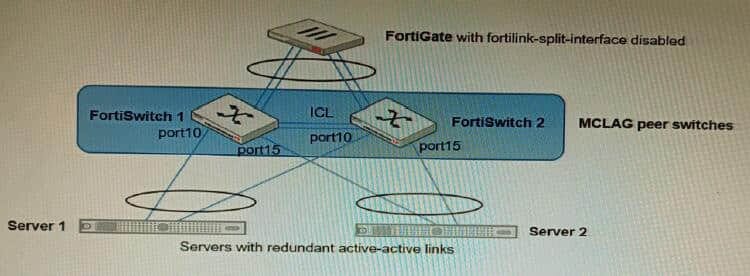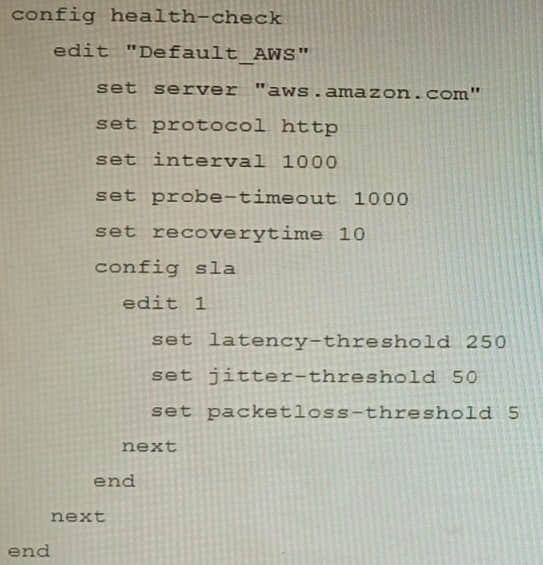Exam Details
Exam Code
:NSE8_812Exam Name
:Network Security Expert 8 Written ExamCertification
:Fortinet CertificationsVendor
:FortinetTotal Questions
:105 Q&AsLast Updated
:Aug 03, 2025
Fortinet Fortinet Certifications NSE8_812 Questions & Answers
-
Question 1:
Refer to the exhibits.

The exhibits show a FortiMail network topology, Inbound configuration settings, and a Dictionary Profile.
You are required to integrate a third-party's host service (srv.thirdparty.com) into the e-mail processing path.
All inbound e-mails must be processed by FortiMail antispam and antivirus with FortiSandbox integration. If the email is clean, FortiMail must forward it to the third-party service, which will send the email back to FortiMail for final delivery, FortiMail must not scan the e-mail again.
Which three configuration tasks must be performed to meet these requirements? (Choose three.)
A. Change the scan order in FML-GW to antispam-sandbox-content.
B. Apply the Catch-Ail profile to the CFInbound profile and configure a content action profile to deliver to the srv. thirdparty. com FQDN
C. Create an access receive rule with a Sender value of srv. thirdparcy.com, Recipient value of *@acme.com, and action value of Safe
D. Apply the Catch-AII profile to the ASinbound profile and configure an access delivery rule to deliver to the 100.64.0.72 host.
E. Create an IP policy with a Source value of 100. 64 .0.72/32, enable precedence, and place the policy at the top of the list.
-
Question 2:
Refer to the exhibit.

The exhibit shows two error messages from a FortiGate root Security Fabric device when you try to configure a new connection to a FortiClient EMS Server.
Referring to the exhibit, which two actions will fix these errors? (Choose two.)
A. Verify that the CRL is accessible from the root FortiGate
B. Export and import the FortiClient EMS server certificate to the root FortiGate.
C. Install a new known CA on the Win2K16-EMS server.
D. Authorize the root FortiGate on the FortiClient EMS
-
Question 3:
Refer to the exhibit.

You have been tasked with replacing the managed switch Forti Switch 2 shown in the topology. Which two actions are correct regarding the replacement process? (Choose two.)
A. After replacing the FortiSwitch unit, the automatically created trunk name does not change
B. CLAG-ICL needs to be manually reconfigured once the new switch is connected to the FortiGate
C. After replacing the FortiSwitch unit, the automatically created trunk name changes.
D. MCLAG-ICL will be automatically reconfigured once the new switch is connected to the FortiGate.
-
Question 4:
You are creating the CLI script to be used on a new SD-WAN deployment You will have branches with a different number of internet connections and want to be sure there is no need to change the Performance SLA configuration in case more connections are added to the branch.
The current configuration is:

Which configuration do you use for the Performance SLA members?
A. set members any
B. set members 0
C. current configuration already fulfills the requirement
D. set members all
-
Question 5:
You must analyze an event that happened at 20:37 UTC. One log relevant to the event is extracted from FortiGate logs:

The devices and the administrator are all located in different time zones Daylight savings time (DST) is disabled The FortiGate is at GMT-1000. The FortiAnalyzer is at GMT-0800 Your browser local time zone is at GMT-03.00
You want to review this log on FortiAnalyzer GUI, what time should you use as a filter?
A. 20:37:08
B. 10:37:08
C. 17:37:08
D. 12.37:08
-
Question 6:
You must configure an environment with dual-homed servers connected to a pair of FortiSwitch units using an MCLAG.
Multicast traffic is expected in this environment, and you should ensure unnecessary traffic is pruned from links that do not have a multicast listener.
In which two ways must you configure the igmps-f lood-traffic and igmps-flood-report settings? (Choose two.)
A. disable on ICL trunks
B. enable on ICL trunks
C. disable on the ISL and FortiLink trunks
D. enable on the ISL and FortiLink trunks
-
Question 7:
Refer to the exhibits.

A customer has deployed a FortiGate with iBGP and eBGP routing enabled. HQ is receiving routes over eBGP from ISP 2; however, only certain routes are showing up in the routing table-Assume that BGP is working perfectly and that the only possible modifications to the routing table are solely due to the prefix list that is applied on HQ.
Given the exhibits, which two routes will be active in the routing table on the HQ firewall? (Choose two.)
A. 172.16.204.128/25
B. 172.16.201.96/29
C. 172,620,64,27
D. 172.16.204.64/27
-
Question 8:
Refer to the exhibit.

A customer has deployed a FortiGate 200F high-availability (HA) cluster that contains and TPM chip. The exhibit shows output from the FortiGate CLI session where the administrator enabled TPM.
Following these actions, the administrator immediately notices that both FortiGate high availability (HA) status and FortiManager status for the FortiGate are negatively impacted.
What are the two reasons for this behavior? (Choose two.)
A. The private-data-encryption key entered on the primary did not match the value that the TPM expected.
B. Configuration for TPM is not synchronized between FortiGate HA cluster members.
C. The FortiGate has not finished the auto-update process to synchronize the new configuration to FortiManager yet.
D. TPM functionality is not yet compatible with FortiGate HA D The administrator needs to manually enter the hex private data encryption key in FortiManager
-
Question 9:
Refer to the exhibit.

A customer has deployed a FortiGate 300E with virtual domains (VDOMs) enabled in the multi-VDOM mode. There are three VDOMs: Root is for management and internet access, while VDOM 1 and VDOM 2 are used for segregating internal traffic. AccountVInk and SalesVInk are standard VDOM links in Ethernet mode.
Given the exhibit, which two statements below about VDOM behavior are correct? (Choose two.)
A. You can apply OSPF routing on the VDOM link in either PPP or Ethernet mode
B. Traffic on AccountVInk and SalesVInk will not be accelerated.
C. The VDOM links are in Ethernet mode because they have IP addressed assigned on both sides.
D. Root VDOM is an Admin type VDOM, while VDOM 1 and VDOM 2 are Traffic type VDOMs.
E. OSPF routing can be configured between VDOM 1 and Root VDOM without any configuration changes to AccountVInk
-
Question 10:
Refer to the exhibits.

A FortiGate cluster (CL-1) protects a data center hosting multiple web applications. A pair of FortiADC devices are already configured for SSL decryption (FAD-1), and re-encryption (FAD-2). CL-1 must accept unencrypted traffic from FAD-1,
perform application detection on the plain-text traffic, and forward the inspected traffic to FAD-2.
The SSL-Offload-App-Detect application list and SSL-Offload protocol options profile are applied to the firewall policy handling the web application traffic on CL-1.
Given this scenario, which two configuration tasks must the administrator perform on CL-1? (Choose two.)

A. Option A
B. Option B
C. Option C
D. Option D
Related Exams:
FCP_FAZ_AD-7.4
FCP - FortiAnalyzer 7.4 AdministratorFCP_FGT_AD-7.4
FCP - FortiGate 7.4 AdministratorFCP_FGT_AD-7.6
FortiGate 7.6 Administrator FCP_FGT_AD-7.6FCP_WCS_AD-7.4
FCP - AWS Cloud Security 7.4 AdministratorFCSS_EFW_AD-7.4
FCSS - Enterprise Firewall 7.4 AdministratorFCSS_NST_SE-7.4
FCSS - Network Security 7.4 Support EngineerFCSS_SASE_AD-24
FCSS - FortiSASE 24 AdministratorNSE4_FGT-5.6
Fortinet NSE 4 - FortiOS 5.6NSE4_FGT-6.0
Fortinet NSE 4 - FortiOS 6.0NSE4_FGT-6.4
Fortinet NSE 4 - FortiOS 6.4
Tips on How to Prepare for the Exams
Nowadays, the certification exams become more and more important and required by more and more enterprises when applying for a job. But how to prepare for the exam effectively? How to prepare for the exam in a short time with less efforts? How to get a ideal result and how to find the most reliable resources? Here on Vcedump.com, you will find all the answers. Vcedump.com provide not only Fortinet exam questions, answers and explanations but also complete assistance on your exam preparation and certification application. If you are confused on your NSE8_812 exam preparations and Fortinet certification application, do not hesitate to visit our Vcedump.com to find your solutions here.